The elliptical machine is one of the best tools for achieving your weight loss goals. Here’s a look at each type of elliptical machine, including the pros and cons of each, so that you can use the right one for you and your training goals.
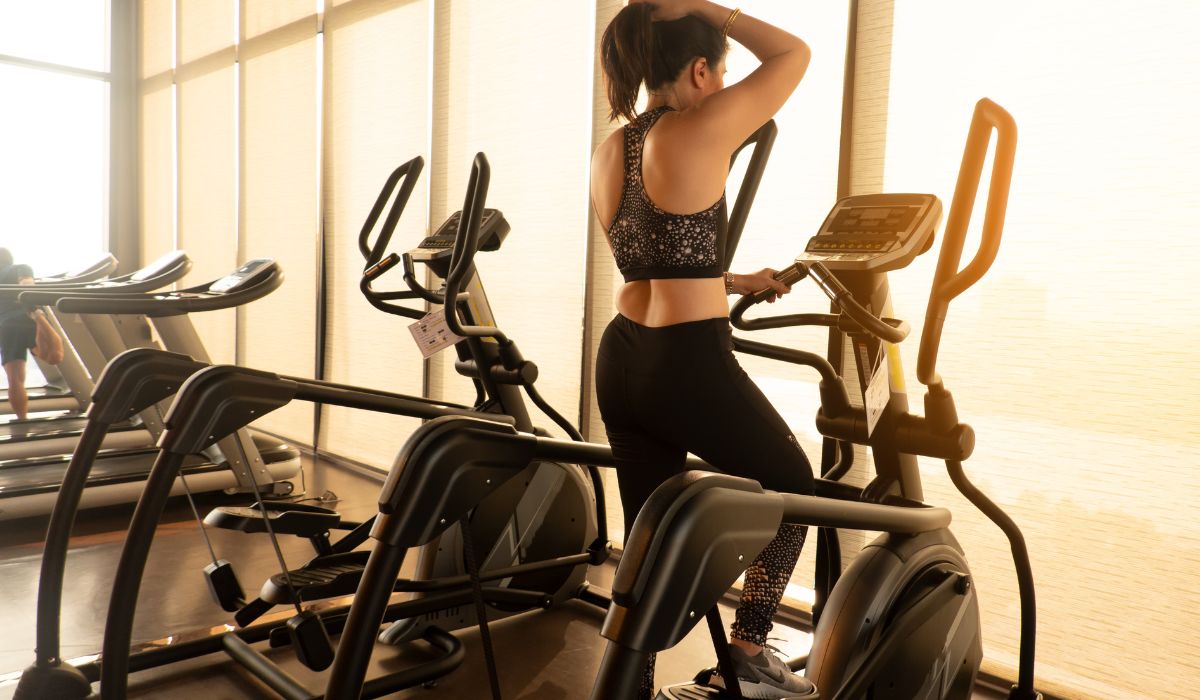
The elliptical machine is fast becoming one of the most popular cardio trainers at the gym, thanks to its low-impact, high-efficiency exercise.
Now, when you walk into pretty much any gym around the country, you’ll find not just one elliptical machine, but a surprising number of them in multiple styles and configurations.
But what are they all? Why do some have the wheel at the rear, others at the front, and others no wheel at all? Why do some move forward and backward while others side to side?
In this post, we’re going to find out!
Below, I’ll take you on a deep-dive into all the different types of elliptical machines found in your gym, looking at their various functions, examining pros and cons, and helping you understand why each exists and how you can use them for maximum effectiveness on your workout.
Let’s jump right in.
What is an Elliptical Machine?
The elliptical machine combines movable handles that you grip firmly in each hand with pedals that allow you to step smoothly forward (though going backward on an elliptical is absolutely a thing, too!).
The pedals encourage natural movement, reduce impact, and allow you to pedal as fast or slow as you want—all benefits of the elliptical trainer.
Because it engages your entire body, it’s one of the best cardio machines for weight loss. You’ll find there are more calories burned on the elliptical machine than on pretty much any other machine in the gym.
You also get a better workout, engaging more muscles than most of the other machines. And, if your goal is to push yourself to the max, it’s one of the best HIIT machines, too.
All pretty clear reasons to incorporate an elliptical machine into your workouts at the gym—or, if you’re setting up your own gym at home, to buy one to install.
But as you’ve probably seen, there are quite a few types of elliptical machines on the market, all with different configurations and used for different workouts. So you’re probably not quite sure what they all do or how to use them.
That’s exactly what we’ll talk about in the next section…
The Different Types of Elliptical Machines
Here is a closer look at the different types of each elliptical, including pros and cons of each.
Rear Drive Elliptical
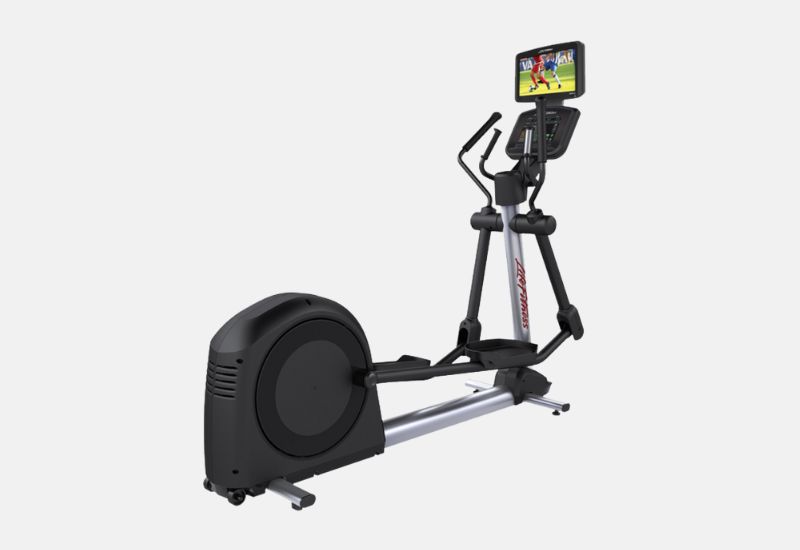
Rear drive ellipticals are designed with the magnetic flywheel set behind the user.
They were actually the first ellipticals ever built (way back in the 1990s), and were the models that everyone started using and grew familiar with (before improvements were made, as you’ll see below).
Because the flywheel is located behind the user, it creates a more circular movement when you pedal than with other ellipticals.
There’s also a bit more bounce up and down with every step, which feels less natural. However, it does encourage a straighter posture, reducing the strain on your spine as you stride on the machine.
 PROS PROS |  CONS CONS |
| Smooth walking or running motion | Old, “outdated” design |
| Encourages more upright posture | Takes up a lot of room |
| Less slope, so harder to increase incline | |
| Great for beginners; easy to learn to use |
Center Drive Elliptical
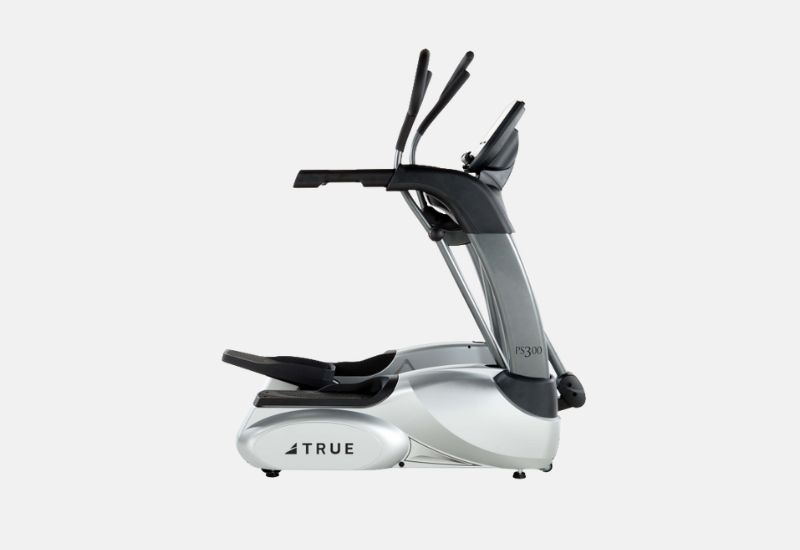
The center drive elliptical is one of the most modern designs available today. Instead of placing the magnetic flywheel behind the user, it’s placed on either side of the user, connected by a single shaft that joins the two motors together beneath the pedals.
The design is far more compact than either front or rear drive ellipticals, making it a significantly better choice for installing in your home gym.
The design also encourages better, more natural biomechanics, meaning it’s gentler on your hip, knee, and ankle joints.
You can typically work out for much longer on these machines because they’re more comfortable and less likely to cause joint fatigue.
However, they tend to be the priciest of the elliptical machines on the market.
 PROS PROS |  CONS CONS |
| More natural, smoother biomechanical movement | Pricey |
| Easier to balance hands-free | No option for wide pedal spacing |
| More compact; takes up less space | |
| Typically offers more resistance |
Front Drive Elliptical
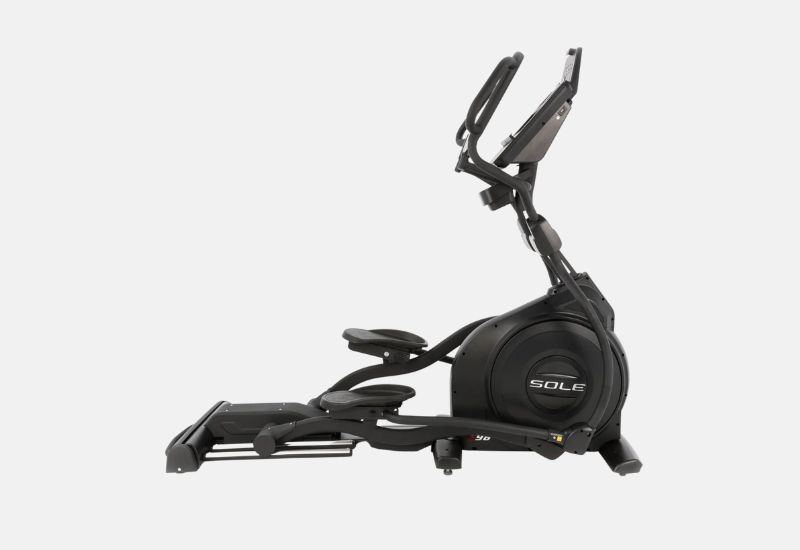
The front drive elliptical places the magnetic flywheel in front of you, rather than behind you or on either side of you.
This is the second-generation design (considered an “upgrade” from the front drive, but the predecessor to the center drive).
With the flywheel placed in front of you, there is a bit more bounce in each step, but it’s easier for the machine to generate a slope or incline.
Front drive ellipticals offer you to ability to raise the incline to the point where it feels like you’re on a stair climber, with more focus on the glutes and quads.
You will have to fight not to lean forward when on the front drive elliptical machines, but instead keep your balance shifted backward and your posture upright.
And, thanks to the fact that the flywheel is located beneath the console, it’s a more compact machine than the rear-drive elliptical (though not quite as compact as the center drive).
 PROS PROS |  CONS CONS |
| 2nd generation models are more affordable | Causes you to lean forward |
| Offers steeper inclines for glute-busting workouts | Stride has more “bounce” |
| Great for improving balance | |
| More compact vs rear-drive ellipticals |
Elliptical Glider
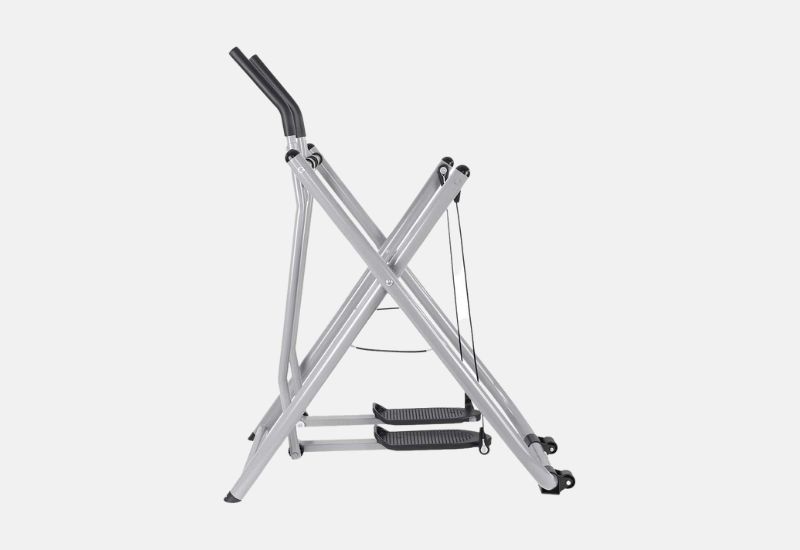
For those who want an ultra-compact, ultra-portable elliptical machine, the elliptical glider is a game-changer!
Unlike the other elliptical machine listed above and below, it has no built-in motor or flywheel. Instead, it uses your own bodyweight as the source of resistance. Your arms and legs are the only thing supporting your bodyweight, and you have to stride and work the handles to move forward.
The elliptical glider is ideal for those with little-to-no space in their home gym, as it’s light enough that you can move it around and won’t need a lot of room to be stored.
It gives you all the workout options of a regular elliptical and can be adjusted to your preferred stance, stride, and posture.
However, be aware that it doesn’t offer multiple levels of resistance or adjustable incline. It’s a “What You See is What You Get” sort of machine.
 PROS PROS |  CONS CONS |
| Compact and affordable | May be difficult for heavier users |
| Smooth, natural motion | Steep learning curve and balancing properly |
| Easily modify difficulty by increasing tempo | |
| Great for use in home gyms |
Elliptical Cross-Trainer
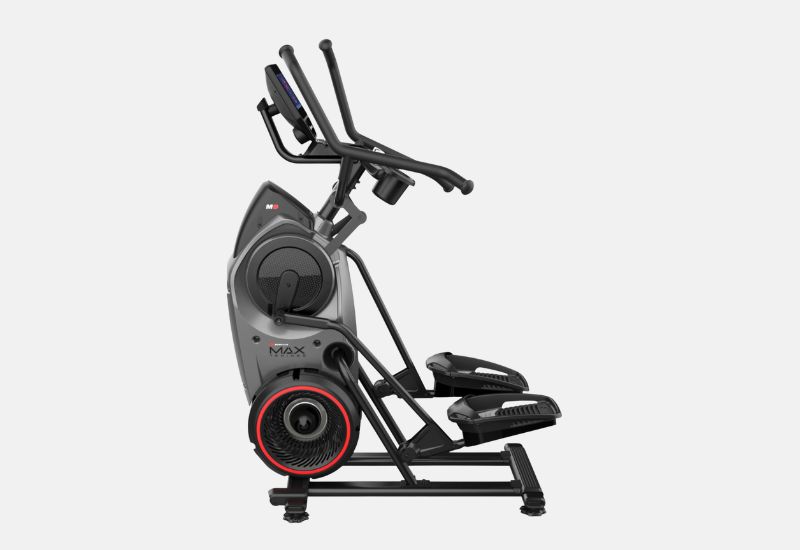
The elliptical cross-trainer is a machine designed to be used for various types of workouts (hence the name “cross-trainer”).
With the cross-trainer, you can walk as normal, speed up to simulate running, increase the resistance to simulate hill walking or climbing, and raise the incline to simulate climbing stairs. It’s designed to replace your treadmill and Stairmaster, giving you a complete cardio workout in one machine.
(See also: Elliptical Machine vs Stairmaster: Which One is a Better Workout?)
It’s definitely the most versatile and most compact of the elliptical machines, and combines all the best design features of the rear drive elliptical with the functionality of a stair climber and treadmill.
However, it’s both pricier and bulkier than most of the other ellipticals, with a much more difficult assembly process.
It’s a great machine to use at the gym, but might not be suitable for use at home.
 PROS PROS |  CONS CONS |
| Simulate walking, running and stair-climbing | Expensive |
| Effective full-body workout | Can be bulky; may be too large for home gyms |
| Increased glute and quad activation | |
| The most versatile of the elliptical machines |
Recumbent Elliptical
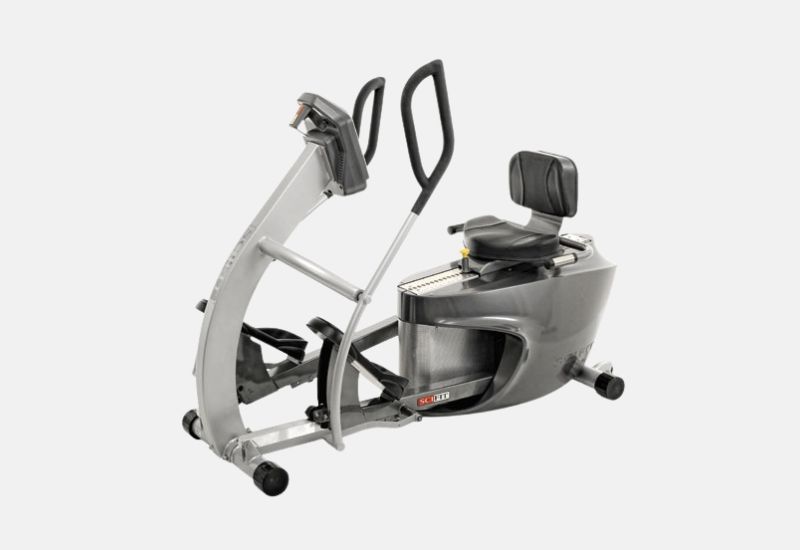
The recumbent elliptical is designed to be used in a sitting-down position, with most of your bodyweight supported by the seat rather than by your legs.
This will definitely give you a less effective workout overall, but it’s particularly effective for those who are recovering from joint injuries or surgeries, or who struggle to support their own bodyweight.
It’s also a suitable option for newbies who are just getting into training and or senior citizens trying to get strong enough to push themselves on the standard elliptical machine.
(Recumbent ellipticals are also seen as elliptical bike combination machines. The ProForm Hybrid Trainer XT is an example of such a machine.)
The recumbent elliptical is no larger than most front or rear drive ellipticals, so it’s still suitable for use at home. However, it tends to be much pricier.
 PROS PROS |  CONS CONS |
| Limited strain on joints | Less effective for experienced trainees |
| Easy learning curve; beginner friendly | Expensive |
| Excellent for rehab | |
| More effective vs recumbent bikes |
Lateral Elliptical
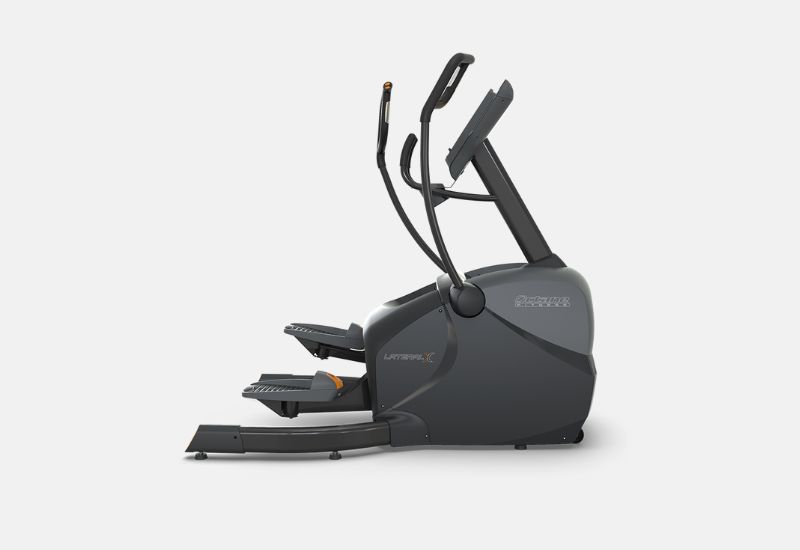
The lateral elliptical, like the elliptical cross-trainer, is a machine designed to give you a more versatile, adaptable workout. At the “normal” settings, it will move virtually identically to an elliptical, with a smooth forward-and-backward stride.
However, with a few adjustments, you can add much more lateral movement into your stride, so you end up taking steps from side to side rather than just straight ahead.
This gives you a workout that specifically targets your outer glutes, quads, and the hip muscles, encouraging both mobility and flexibility.
Like elliptical cross-trainers, they tend to be on the pricier side. They’ll also occupy more space to either side of the machine, and their central housing is often bulkier than the standard flywheel used in front or rear drive ellipticals.
However, if you really want to get in a killer workout focusing on the lesser-used leg muscles, it’s a great machine!
 PROS PROS |  CONS CONS |
| Target out glutes, outer quads and hips | Takes up more room than regular ellipticals |
| Improves athletic agility | Expensive |
| Versatile; use for both standard and lateral training | |
| Great way to mix up elliptical training |
Compact or Foldable
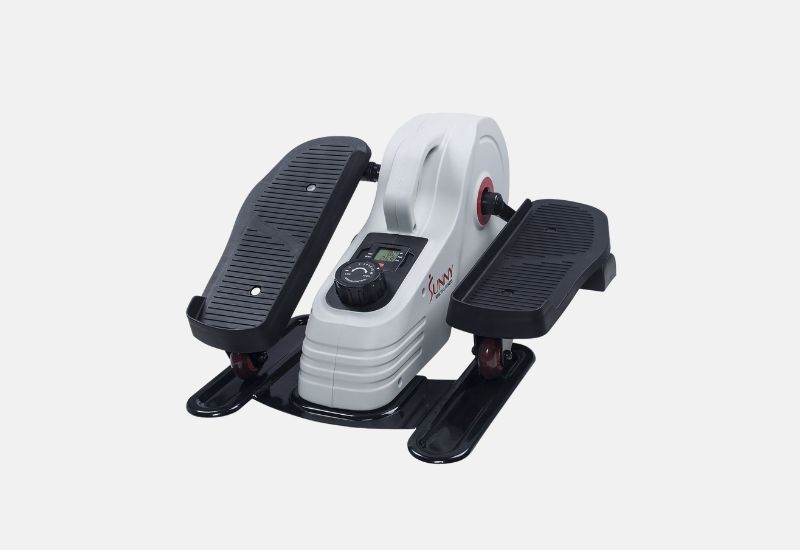
Last, but definitely not least, we’ve got the compact or foldable elliptical machine.
The compact elliptical is basically just the pedals mounted onto a small flywheel, and the entire machine is sized small enough that you can slide it under your desk to pedal while you’re working.
Some models can be used while standing, but many are designed to be used while you’re sitting down (similar to an under-the-desk exercise bike).
Foldable elliptical machines are a bit bigger—they feature the pedals, flywheel, and handles—but they are designed to fold down small enough that you can tuck them into a corner and store them out of the way when not in use.
It goes without saying that neither of these two ellipticals can offer the same versatility as the larger machines, but they tend to be cheaper and better for use at home or your office.
 PROS PROS |  CONS CONS |
| Compact and portable | Fewer resistance levels |
| Great for desk sitters | Not the sturdiest option |
| Awesome for using while watching TV, etc | |
| Small enough for any home gym |
The Bottom Line
As you can see, there are quite a few styles of elliptical machines to choose from, each with their specific pros and cons.
It’s up to you consider each and see which will suit your needs best, based on the amount of space you have to work with, the type of workouts you want to do, and certainly your budget.
Thankfully, all of these machines can give you a great workout, so whichever you choose, you’ll end up a winner!
More Elliptical Guides and Resources
4 Killer 30-Minute Elliptical Workouts (HIIT, Building Glutes, and More). The elliptical machine is a killer tool for getting in shape. And the good news is that you don’t have to spend hours on it to see results. Here are four 30-minute elliptical workouts, including HIIT, glute-focused, steady-state, and more.
How Much Do Ellipticals Cost? (44 Different Models Compared). Ellipticals can be a costly investment in your workout goals. Here is a look at how much each type of elliptical costs and how much to spend on one.